ignition Citroen DS5 HYBRID 2016 1.G Repair Manual
[x] Cancel search | Manufacturer: CITROEN, Model Year: 2016, Model line: DS5 HYBRID, Model: Citroen DS5 HYBRID 2016 1.GPages: 376, PDF Size: 12.57 MB
Page 188 of 376

Seat belts
Front seat beltsRear seat belts
The rear seats are each fitted with a seat belt,
three-point anchorages with inertia reel and
force limiter (except for the centre rear seat).Fastening
F Pull the strap, then insert the tongue in the
buc
kle.
F
Ch
eck that the seat belt is fastened
correctly by pulling the strap.
Unfastening
F Press the red button on the buckle.
F Gu ide the seat belt as it reels in.
The front seat belts are fitted with a
pretensioning and force limiting system.
This system improves safety in the front
seats in the event of a front or side impact.
Depending on the severity of the impact, the
pretensioning system instantly tightens the seat
belts against the body of the occupants.
The pretensioning seat belts are active when
the ignition is on.
The force limiter reduces the pressure of the
seat belt on the chest of the occupant,
so improving their protection.
Page 189 of 376
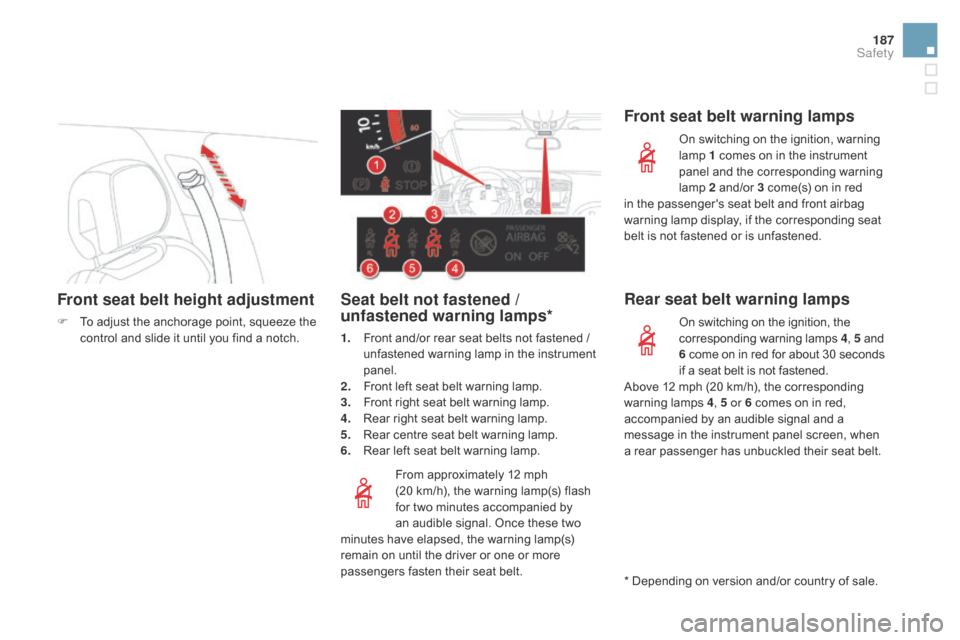
187
DS5_en_Chap07_securite_ed02-2015
Front seat belt height adjustment
F To adjust the anchorage point, squeeze the
control and slide it until you find a notch.
From approximately 12 mph
(20
k
m/h), the warning lamp(s) flash
for two minutes accompanied by
an audible signal. Once these two
minutes have elapsed, the warning lamp(s)
remain on until the driver or one or more
passengers fasten their seat belt.
Seat belt not fastened /
unfastened warning lamps*
1. Front and/or rear seat belts not fastened /
u nfastened warning lamp in the instrument
panel.
2.
Fr
ont left seat belt warning lamp.
3.
Fr
ont right seat belt warning lamp.
4.
Re
ar right seat belt warning lamp.
5.
Re
ar centre seat belt warning lamp.
6.
Re
ar left seat belt warning lamp.
Front seat belt warning lamps
On switching on the ignition, warning
lamp 1 comes on in the instrument
panel and the corresponding warning
lamp 2 and/or 3 come(s) on in red
in the passenger's seat belt and front airbag
warning lamp display, if the corresponding seat
belt is not fastened or is unfastened.
Rear seat belt warning lamps
On switching on the ignition, the
corresponding warning lamps 4, 5 and
6 come on in red for about 30
s
econds
if a seat belt is not fastened.
Above 12 mph (20 km/h), the corresponding
warning lamps 4, 5 or 6 comes on in red,
accompanied by an audible signal and a
message in the instrument panel screen, when
a rear passenger has unbuckled their seat belt.
* Depending on version and/or country of sale.
Safety
Page 191 of 376

189
DS5_en_Chap07_securite_ed02-2015
Airbags
General information
System designed to contribute towards
improving the safety of the occupants (with
the exception of the rear centre passenger)
in the event of violent collisions. The airbags
supplement the action of the seat belts fitted
with force limiters (all except the centre rear
passenger belt).
If a collision occurs, the electronic detectors
record and analyse the front and side impacts
sustained in the impact detection zones:
-
in t
he case of a serious impact, the airbags
are deployed instantly and contribute
towards better protection of the occupants
of the vehicle (with the exception of the
rear centre passenger); immediately after
the impact, the airbags deflate rapidly so
that they do not hinder visibility or the exit
of the occupants,
-
in t
he case of a minor or rear impact or in
certain roll-over conditions, the airbags
may not be deployed; the seat belt
alone contributes towards ensuring your
protection in these situations.
The airbags do not operate when the
ignition is switched off. Deployment of one or more of the
airbags is accompanied by a slight
emission of smoke and a noise, due
to the activation of the pyrotechnic
cartridge incorporated in the system.
This smoke is not harmful, but sensitive
individuals may experience slight
irritation.
The noise of detonation related to the
deployment of one or more airbags may
result in a slight loss of hearing for a
short time.
Impact detection zones
A. Front impact zone.
B. Si de impact zone.
Front airbags
deployment
The airbags are deployed, except the
passenger's front airbag if it is deactivated, in the
event of a serious front impact to all or part of the
front impact zone A , in the longitudinal centreline
of the vehicle on a horizontal plane and directed
from the front to the rear of the vehicle.
The front airbag inflates between the thorax and
head of the front occupant of the vehicle and the
steering wheel, driver's side, and the dashboard,
passenger's side to cushion their for ward
movement. System which protects the driver and front
passenger in the event of a serious front impact
in order to limit the risk of injury to the head and
thorax.
The driver's airbag is fitted in the centre of the
steering wheel; the front passenger's airbag is
fitted in the dashboard above the glove box.
This equipment will only deploy once.
If a second impact occurs (during the
same or a subsequent accident), the
airbag will not be deployed again.
Safety
Page 192 of 376
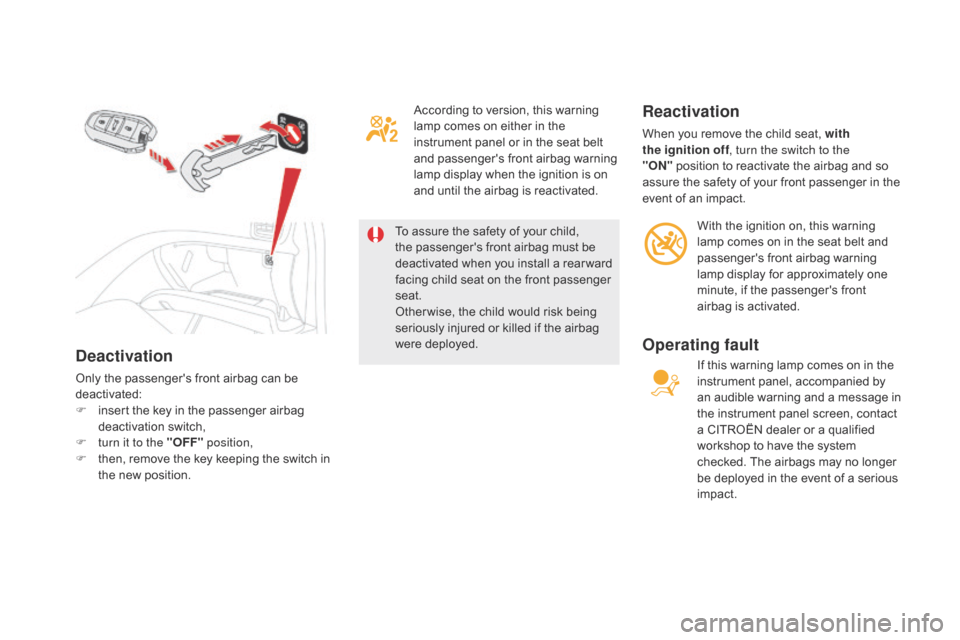
deactivation
Only the passenger's front airbag can be
deactivated:
F
in
sert the key in the passenger airbag
deactivation switch,
F
tu
rn it to the "OFF" position,
F
th
en, remove the key keeping the switch in
the new position. According to version, this warning
lamp comes on either in the
instrument panel or in the seat belt
and passenger's front airbag warning
lamp display when the ignition is on
and until the airbag is reactivated.
To assure the safety of your child,
the passenger's front airbag must be
deactivated when you install a rear ward
facing child seat on the front passenger
seat.
Other wise, the child would risk being
seriously injured or killed if the airbag
were deployed.
Reactivation
When you remove the child seat, with
the ignition off , turn the switch to the
"ON"
p
osition to reactivate the airbag and so
assure the safety of your front passenger in the
event of an impact.
With the ignition on, this warning
lamp comes on in the seat belt and
passenger's front airbag warning
lamp display for approximately one
minute, if the passenger's front
airbag is activated.
Operating fault
If this warning lamp comes on in the
instrument panel, accompanied by
an audible warning and a message in
the instrument panel screen, contact
a CITROËN dealer or a qualified
workshop to have the system
checked. The airbags may no longer
be deployed in the event of a serious
impact.
Page 200 of 376
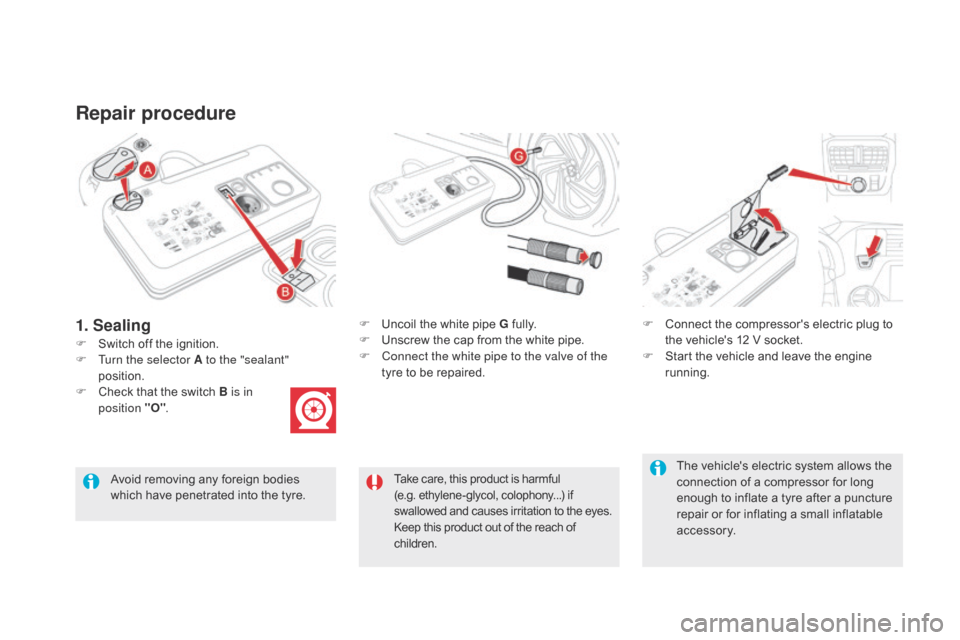
DS5_en_Chap08_info-pratiques_ed02-2015
Repair procedure
F Switch off the ignition.F
Un
coil the white pipe G fully.
F Un screw the cap from the white pipe.
F Co nnect the white pipe to the valve of the
tyre to be repaired. F
Co
nnect the compressor's electric plug to
the vehicle's 12 V socket.
F St art the vehicle and leave the engine
running.
Take care, this product is harmful
(e.g. e thylene-glycol, colophony...) if
swallowed and causes irritation to the eyes.
Keep this product out of the reach of
children.Avoid removing any foreign bodies
which have penetrated into the tyre.
1. Sealing
F Turn the selector A to the "sealant"
p osition.
F
Ch
eck that the switch B is in
position "O" .
The vehicle's electric system allows the
connection of a compressor for long
enough to inflate a tyre after a puncture
repair or for inflating a small inflatable
accessory.
Page 208 of 376

DS5_en_Chap08_info-pratiques_ed02-2015
Removing a wheel
Parking the vehicle
Immobilise the vehicle where it does not
block traffic: the ground must be level,
stable and not slippery.
Apply the parking brake unless it has
been programmed to automatic mode,
switch off the ignition and engage first
gear* to block the wheels.
Check that the braking warning lamp
and the P warning lamp in the parking
brake control lever come on.
If necessary, place a chock against
the wheel opposite the wheel to be
changed.
The occupants must get out of the
vehicle and wait where they are safe.List of operations
F Depending on equipment, remove the protective cover from from each of bolts using the tool 3
or remove the wheel trim using tool 4 .
F
Fi
t the security socket 5 on the wheelbrace 1 to slacken the security bolt (if fitted).
F
Sl
acken the other bolts (no more than a 1/4 turn) using the wheelbrace 1 o n l y.
* Position P for an automatic gearbox.
Never go underneath a vehicle raised
using a jack; use an axle stand.
Page 221 of 376

219
DS5_en_Chap08_info-pratiques_ed02-2015
Changing a fuse
The fuse extraction tweezer is fitted to the back
of the dashboard fusebox cover.
For access to it:
F
re
move the cover completely and turn it
ove r,
F
re
move the tweezer.
Access to tooling
Before changing a fuse, it is necessary to:
F identify the cause of the failure and
correct it,
F
sw
itch off all electrical consumers,
F
im
mobilise the vehicle and switch off the
ignition,
F
id
entify the failed fuse using the allocation
tables and diagrams presented on the
following pages.
changing a fuse
Good Failed
To remove or fit a fuse, it is essential to:
F
us
e the special tweezer to extract the fuse
from its housing and check the condition of
its filament.
F
al
ways replace the failed fuse with a fuse
of the same rating (same colour); a fuse of
different rating could cause a fault (risk of
f i r e).
The replacement of a fuse not
mentioned in the tables below could
cause a serious malfunction of your
vehicle. Contact a CITROËN dealer or a
qualified workshop.
If the fault recurs after replacing a fuse, have
the electrical system checked by a CITROËN
dealer or a qualified workshop. Tw e e z e r
Practical information
Page 226 of 376

DS5_en_Chap08_info-pratiques_ed02-2015
Starting using another
battery
Never try to start the engine by
connecting a battery charger.
Never use a 24 V or higher battery
b o o s t e r.
First check that the slave battery has a
nominal voltage of 12 V and a capacity
at least equal to that of the discharged
battery.
The two vehicles must not be in contact
with each other.
Switch off the electrical consumers on
both vehicles (audio system, wipers,
lighting, ...).
Ensure that the jump lead cables do
not pass close to moving parts of the
engine (cooling fan, belts, ...).
Do not disconnect the (+) terminal when
the engine is running.F
St
art the engine of the vehicle with the
good battery and leave it running for a
few
mi
nutes.
F Op erate the starter on the broken down
vehicle and let the engine run.
If t
he engine does not start straight away,
switch off the ignition and wait a few
moments before trying again.
When your vehicle's battery is discharged, the
engine can be started using a slave battery
(external or on another vehicle) and jump lead
cables or a battery booster.
F
Wa
it until the engine returns to idle then
disconnect the jump lead cables in the
reverse order.
F
Re
fit the plastic cover to the (+) terminal, if
your vehicle has one.
F
Al
low the engine to run for at least
30
m
inutes, by driving or with the vehicle
stationary, so that the battery reaches an
adequate state of charge.
F
Ra
ise the plastic cover on the (+) terminal,
if your vehicle has one.
F
Co
nnect the red cable to the positive
terminal (+) of the flat battery A (at the metal
elbow) then to the positive terminal
(
+) of the
slave battery B or the booster.
F
Co
nnect one end of the green or black
cable to the negative terminal (-) of the
slave battery B or the booster (or earth
point on the other vehicle). Some functions, including Stop & Start,
are not available if the battery is not
sufficiently charged.
F
Co
nnect the other end of the green or black
cable to the earth point
c o
n the broken
down vehicle.
Page 227 of 376
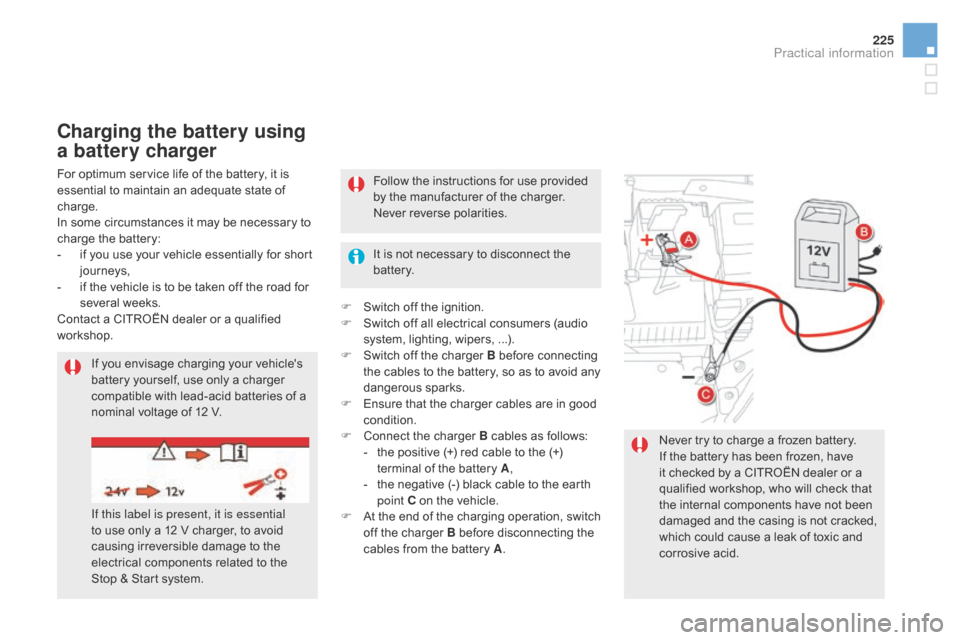
225
DS5_en_Chap08_info-pratiques_ed02-2015
For optimum service life of the battery, it is
essential to maintain an adequate state of
charge.
In some circumstances it may be necessary to
charge the battery:
-
if y
ou use your vehicle essentially for short
journeys,
-
if t
he vehicle is to be taken off the road for
several weeks.
Contact a CITROËN dealer or a qualified
workshop.
charging the battery using
a b attery charger
Never try to charge a frozen battery.
If the battery has been frozen, have
it checked by a CITROËN dealer or a
qualified workshop, who will check that
the internal components have not been
damaged and the casing is not cracked,
which could cause a leak of toxic and
corrosive acid.
If you envisage charging your vehicle's
battery yourself, use only a charger
compatible with lead-acid batteries of a
nominal voltage of 12 V. Follow the instructions for use provided
by the manufacturer of the charger.
Never reverse polarities.
It is not necessary to disconnect the
battery.
F
Sw
itch off the ignition.
F
Sw
itch off all electrical consumers (audio
system, lighting, wipers, ...).
F
Sw
itch off the charger B before connecting
the cables to the battery, so as to avoid any
dangerous sparks.
F
En
sure that the charger cables are in good
condition.
F Co
nnect the charger B cables as follows:
- th
e positive (+) red cable to the (+)
terminal of the battery A ,
-
th
e negative (-) black cable to the earth
point
c o
n the vehicle.
F
At t
he end of the charging operation, switch
off the charger B before disconnecting the
cables from the battery A .
If this label is present, it is essential
to use only a 12 V charger, to avoid
causing irreversible damage to the
electrical components related to the
Stop & Start system.
Practical information
Page 228 of 376
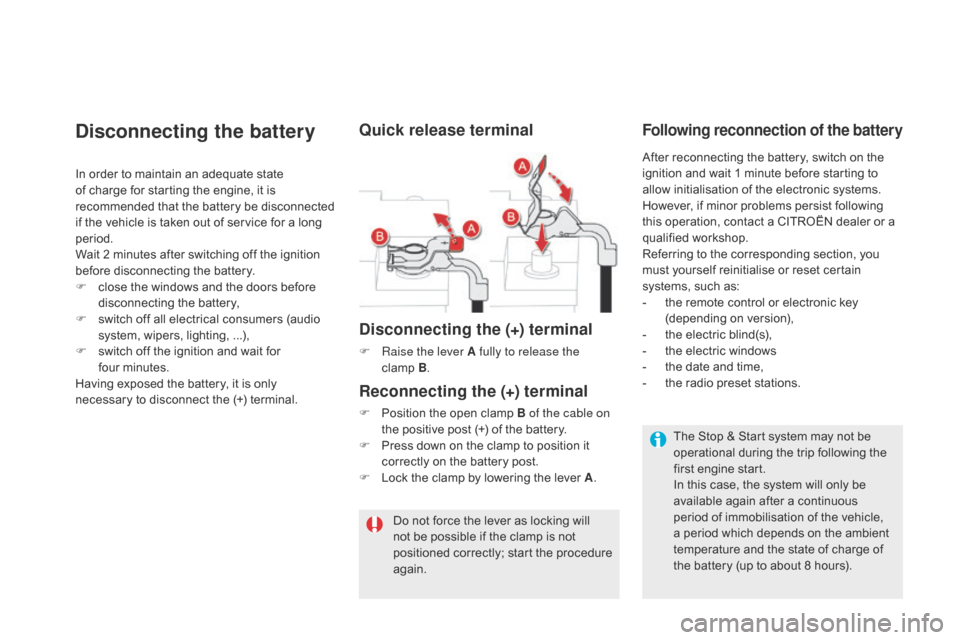
DS5_en_Chap08_info-pratiques_ed02-2015
disconnecting the battery
In order to maintain an adequate state
of charge for starting the engine, it is
recommended that the battery be disconnected
if the vehicle is taken out of service for a long
period.
Wait 2 minutes after switching off the ignition
before disconnecting the battery.
F
cl
ose the windows and the doors before
disconnecting the battery,
F
sw
itch off all electrical consumers (audio
system, wipers, lighting, ...),
F
sw
itch off the ignition and wait for
four
mi
nutes.
Having exposed the battery, it is only
necessary to disconnect the (+) terminal.
Quick release terminal
dis
connecting the (+) terminal
F Raise the lever A fully to release the
c lamp B.
Following reconnection of the battery
Reconnecting the (+) terminal
F Position the open clamp B of the cable on
t
he positive post (+) of the battery.
F
Pr
ess down on the clamp to position it
correctly on the battery post.
F
Lo
ck the clamp by lowering the lever A .
Do not force the lever as locking will
not be possible if the clamp is not
positioned correctly; start the procedure
again. The Stop & Start system may not be
operational during the trip following the
first engine start.
In this case, the system will only be
available again after a continuous
period of immobilisation of the vehicle,
a period which depends on the ambient
temperature and the state of charge of
the battery (up to about 8 hours).
After reconnecting the battery, switch on the
ignition and wait 1 minute before starting to
allow initialisation of the electronic systems.
However, if minor problems persist following
this operation, contact a CITROËN dealer or a
qualified workshop.
Referring to the corresponding section, you
must yourself reinitialise or reset certain
systems, such as:
-
th
e remote control or electronic key
(depending on version),
-
th
e electric blind(s),
-
th
e electric windows
-
th
e date and time,
-
th
e radio preset stations.